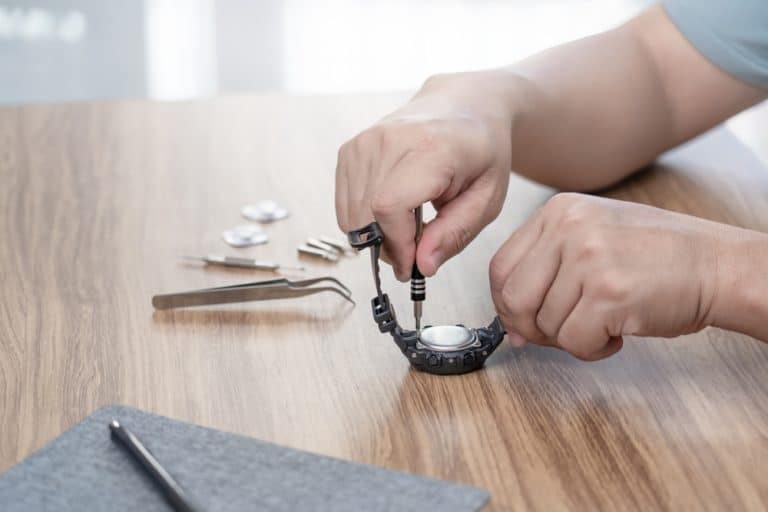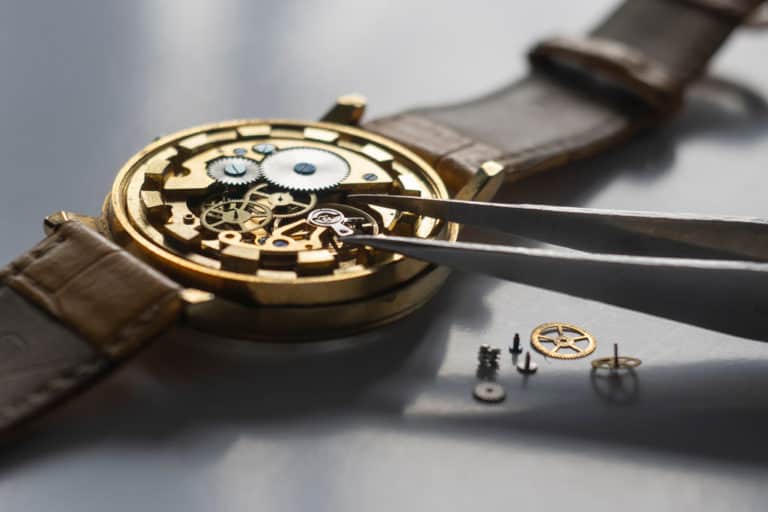Pocket watches are timeless pieces that can offer you a unique piece of the past. You may want to gift one to a close friend or family member, or perhaps you’d like to treat yourself! As a collector, I have pocket watches of all styles and calibers, which can differ substantially in design. So, do pocket watches use batteries?
Old or vintage pocket watches do not have batteries and operate using a mechanical movement. They are more expensive to repair and distribute power with their mainspring. Modern pocket watches use coin or button batteries that are easily replaceable by yourself or a qualified jeweler.
Most manufacturers opt for battery-powered pocket watches because they’re much cheaper to make and maintain, although there’s something special about vintage pocket watches. We’ll explore the differences between battery-powered and mechanical watches, plus we’ll also look at how to change your old battery and know what battery type you need for your pocket watch.
Do Pocket Watches Use Batteries?
Most modern pocket watches use batteries as a much more straightforward way of telling time. However, older pocket watch models, particularly vintage ones, do not work with batteries.
How Are Mechanical Movement Watches Different?
Vintage pocket watches are mostly mechanical movement watches, meaning they have no microchip, circuitry, or battery. The watch’s power gets stored in the mainspring and released in increments via the escapement assembly.
The gears connected to the mainspring and escapement must turn at various speeds to give the watch its ability to tell time accurately.
The mainspring, which gives a mechanical movement pocket watch its power, functions with the help of a pinion that spins in one direction and prevents the mainspring from unwinding.
Near to the mainspring is the wheel train. It consists of three smaller cogwheels that join with the larger cogwheel from the mainspring to make four wheels – the wheel from the mainspring, the center wheel, third and fourth wheel.
The center wheel is closest to the mainspring wheel, turns directly with the mainspring, and operates the minute hand, which rotates once per hour. Similarly, the third wheel gives power to the fourth wheel, which controls the seconds hand, turning once a minute.
Motion works are two cogwheels below the hands that rotate once every 12 hours to keep the correct time. You might see the balance wheel swinging to a rhythm behind a pocket watch. The balance wheel is responsible for releasing small increments of power from the mainspring.
Near the balance wheel is the escapement, a tiny cogwheel with hooked teeth all around. Connected to the balance wheel with a pallet fork, as the ends of the pallet fork slip in and out of the teeth in the escapement, it receives small increments of power from the main spring.
Lastly, all the parts have metal plate supports that keep them together and working correctly.
How Are Battery-Powered Pocket Watches Different?
Pocket watches with batteries don’t rely on mechanical parts to tell time and are typically much more cost-effective than mechanical watches. If the pocket watch stops working, you can replace the battery yourself pretty easily or take it to a jeweler who will have you pay a minimal fee.
Pocket watches with batteries typically work together with a quartz crystal to tell the time, utilizing a quartz movement. The battery produces an electrical current that travels through the quartz crystal, causing it to oscillate around 32 000 times per second.
The vibrations caused during the oscillation process create enough power to keep the pocket watch’s motor, gears, and ultimately, hands moving.
A pocket watch generally takes one button or coin cell battery, which lasts 3 – 10 years, depending on the type of battery. For instance, alkaline and silver oxide button batteries last around three years after production, while lithium batteries are far superior and can last up to 10 years.
When you replace an old battery, it’s wise to use the recommended battery from the manufacturer. However, you can also check your owner’s manual, do a google search, or look inside the backing of your pocket watch to find its battery type.
How Do You Know Which Battery Type To Use?
Pocket watches might look similar in shape but rarely use the same battery type. If you want to know the precise battery type of your pocket watch, you can ask the sales clerk at a watch store, consult your owner’s manual, do a google search or pry open the backing.
Examining the inside of the backing is a surefire way to know your battery type. You’ll see hallmarks that tell you the fine details of your pocket watch. For instance, it might indicate whether the pocket watch is gold-filled or gold-plated, but more importantly, it will show what battery type it needs.
The backing will, for example, battery number 377, meaning the pocket watch requires a type 377 battery to work.
How Do You Wind A Pocket Watch Without A Battery?
To wind your pocket watch, open the front cover, and turn the crown clockwise 10 – 15 times or until there is a slight resistance. Oscillate it slightly to start the watch, pull the stem to loosen the hands, and set the time. Press the stem back in and close the front cover.
You may have received a beautiful pocket watch as a gift, but you’re unsure how to wind a pocket watch without a battery. Fortunately, it’s pretty straightforward once you first learn to do it.
Here are five steps to help you wind your pocket watch without a battery:
- Open the front cover – Press the little button at the top of the stem of your pocket watch to open the front cover.
- Wind the pocket watch – Grip the crown on the watch’s stem between your thumb and index fingers, and turn it clockwise 10 – 15 times. You should hear a slight click as you rotate the stem because the gears at the back are turning.
Do not over-turn the pocket watch; stop turning when you feel the slightest bit of resistance. At this point, the pocket watch will be fully wound.
- Oscillate the pocket watch to start it – Once fully wound, you might need to oscillate the pocket watch to get it going. In this case, grab both sides of the pocket watch with your thumb and index finger and gently swing it from left to right.
- Set the time – Using your thumb and index fingers, grab the crown and gently pull up to pull the stem out – you should hear a slight click.
You can use the crown to adjust the hands on the watch. Once you set the time, push the stem back in to lock the hands.
- Close the front case – Gently push the front case toward the watch until it clicks.
That’s it – you successfully wound your pocket watch and can enjoy it in all its splendor!

How Do You Change A Pocket Watch Battery?
To change your pocket watch battery, first, remove the backing with a prying tool. Check the battery type inside the backing, then remove the white plastic covering that holds the battery in place. Pry out the old battery, slot in the new one, and put back the white plastic cover and backing.
When it comes to replacing your pocket watch battery, you have the option to have it changed by a professional, but changing it yourself is also an option.
Before you start, you’ll need a prying tool – preferably one with a flat edge so you don’t scratch your pocket watch – and something akin to tweezers to manage the tiny bits and battery inside the pocket watch.
Here’s how to change your pocket watch battery:
- Remove the backing of the pocket watch – Find a spot on your pocket watch with a lip. Using your prying tool, gently slide the sharp end between the lip and apply a bit of force to pry open the backing.
- Look inside the backing for a battery type – If you don’t know what kind of battery to use, the inside of the backing has information about the pocket watch, including a battery number or battery type.
- Remove the plastic covering the battery – Once you remove the backing, you should see a white circular plastic covering that holds the pocket watch and the battery in place.
Using your tweezers, gently grab the white plastic cover and remove it to access the battery easily. However, do not pull too hard; otherwise, you will pull the entire watch out of its frame.
- Replace the flat battery with the new one – Once you remove the white plastic cover, you’ll have a good view of the battery. It might be loose or inside a socket; if it’s in a socket, grab your tweezers and gently dig it out, ensuring you don’t scratch the watch.
Hold the new battery between the tweezer’s prongs, and slide it into the battery socket, ensuring that part of the battery with the lip faces down and the top surface is entirely flat.
Use the tweezers to press down gently around the battery to ensure it sits firmly in its socket.
- Put the white plastic cover back – Using your tweezers, put the white plastic cover back over the battery. If you examine the plastic cover closely, you’ll see it has an extended lip that runs inward – place this part directly over the battery.
- Put back the pocket watch backing – Once the plastic covering is secure, go ahead and slot the backing onto the pocket watch, pressing it down until you hear it click. You can usually tell how to put it back by looking at the decorative picture on the back.
Is It More Expensive To Repair A Mechanical Pocket Watch?
Mechanical pocket watches are more expensive to repair because the repair work involves more manual labor and replacing multiple mechanical parts.
Repairing a mechanical movement watch is almost always more expensive than repairing a battery-powered pocket watch because it requires more expertise. If the innermost intricate parts break, a specialized individual might need to make new parts, costing up to several thousand dollars.
The extent of the watch damage and the type of pocket watch is often the most significant contributors to repair costs. Secondly, the materials in the watch, the specialized knowledge to do the repairs, and whether replacement parts are necessary are also essential.
Someone skilled enough to repair the tiny parts in a mechanical pocket watch classifies as a technician and generally charges per hour for their services. It can easily take several hours to repair a broken pocket watch, plus specialized tools if the watchmaker needs to create new parts.
At this point, the price of cleaning out the dirt and oiling the parts is not even part of the equation. The watchmaker needs to diagnose the issue with the pocket watch and will replace any defective parts.
If you’re lucky, replacing the part will need a minor amount of further disassembly and reassembly. If not, you might need to tweak the watch to ensure it maintains the right time, which would require additional skills.
In the worst-case scenario, the watchmaker will need to create new bits and gears to fix an old or customized watch for which no replacement parts are available. In this case, having deep pockets is almost a requirement because you’re talking about many hours of expensive labor by professionals.
Because you’re talking about parts that need to be hand-made to micrometer precision or greater, even minor customizations like removing a pivot might cost thousands of dollars for just that one part.
Conclusion
Old or vintage pocket watches still use a mechanical movement because there were no batteries at the time. Most modern pocket watches utilize a battery because it’s much cheaper to maintain and produce. Furthermore, mechanical watches are much more expensive to repair because of specialized craftsmanship, labor costs, and sometimes having to create custom parts.
Sources
- https://www.youtube.com/watch?v=Z4AGgUgETjM
- https://www.youtube.com/watch?v=-C641z30fJY
- https://www.youtube.com/watch?v=3WGGhF0KQqc
- 1https://www.youtube.com/watch?v=9_QsCLYs2mY
- https://www.youtube.com/watch?v=IgB7g9jx46M
- https://www.youtube.com/watch?v=9_QsCLYs2mY
- https://www.batteryequivalents.com/wrist-watch-battery-replacement-chart.html
- https://www.panasonic-batteries.com/en/faq/what-does-expiry-date-my-coin-battery-mean







